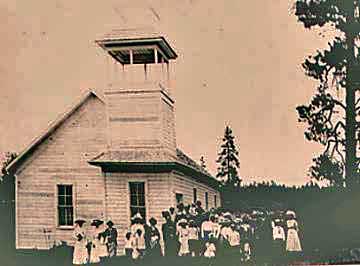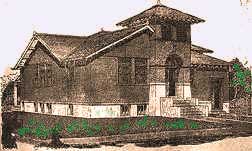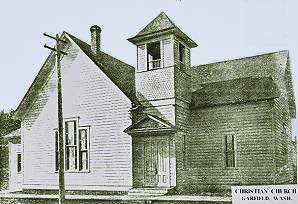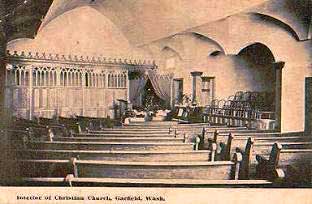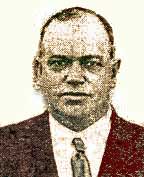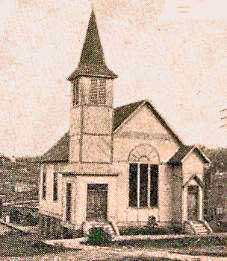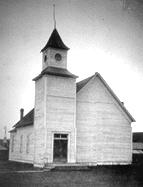 Churches of Christ & Christian Churches in the Pacific Northwest WHITMAN COUNTY, WASHINGTON |
 by Charles Dailey College index |
Albion |
Colfax |
Eden Valley |
Farmington / Pine Creek |
Garfield |
Oakesdale
Palouse |
Pine City |
Pullman |
Rosalia |
St. John |
Steptoe |
Tekoa
Yakima County . . . Pioneer Menu . . . Search - - Oldest presented first.
The county's name honors pioneer missionary Marcus Whitman. He and H. H. Spalding had established a mission near Fort Walla Walla in 1836.The Eden Valley Church of Christ may have been the dream of Edward and Lattice Pedigo. These pioneers of 1854 moved here in 1871 from Oregon where they had been leaders in the Damascus church. They were joined by their son-in-law and daughter, Samuel P. and Betsy Ann Pedigo Gilliland, also 1854 pioneers. Both Pedigo families spent the rest of their lives here. They are buried in the Eden Valley Cemetery.
There is a short autobiography of Edward Pedigo on this link.Another family we can trace is William H. Harrison McClure and his wife Amanda Elizabeth Callison McClure. He was a son of the statesman Vincent Scott McClure and she was a daughter of Gilmore Callison. They had moved to Eden Valley in the 1880s and finished out their lives here. They are also buried in the Eden Valley Cemetery.
There is a profile of Gilmore Callison.The work had its formal beginning in 1878 when Cyrus Jefferson Wright arrived and services were held in the old Turnbow Flat School. Mr. Wright was still based there in 1881 when the group built their own log building, located five miles west of Palouse on the Colfax Road. One historical source says it has the distinction of being the first Christian Church in Whitman County. Converts were baptized in the Palouse River.
There is a profile of C. J. Wright.There is a painting of the first Eden Valley Church.
There is a complete roster of the Eden Valley Church.
The second Eden Valley building.
Milled lumber had become available.
The photo is about 1910.On September 9, 1883, it was reported to the Christian Herald that the church now had 79 members. The W. E. Pedigo family and the John Watson family had just arrived from Monmouth, Oregon, and had united with the Eden Valley Church “by letter.”
The church was incorporated in 1889 as the Eden Valley Church of Christ. The church closed in 1923 as members moved from the area.
The remaining people joined with the Palouse church.
Farmington MapAn earlier name was Pine Creek and it was initially thought to be in Idaho. (Look at the map.)
Amos Buchanan was the messenger of the congregation (as well as for Paradise, Idaho Territory) at a meeting in Waitsburg, Washington Territory. He reported 36 members in 1877.
James Marion Propst (1843-1901) and Ann Eliza Guliford Propst from Albany, Oregon were members of the congregation in the late 1870s. He was an elder along with J. P. Quarles. D. B. Matheny was the preacher in 1878.
F. M. Davis was a member of the church in 1879 and 1880. T. J. Carman was a member of the congregation in 1881. J. P. Quarles was a leader in the congregation during the 1880s.
Another account says that preacher A. C. Vernon arrived in covered wagons in 1883 and began services in a schoolhouse. As a result, a church was organized on Pine Creek in 1889 with 20 members. The believers built in 1890, just east of Cozier's Ford.
Preacher Thomas McBride Morgan and Rachel Barnes Morgan lived here for a short time after they left Bethel, Oregon.
Palouse Map
Palouse is from a French word meaning the grass lands.
We can pinpoint the beginning of the "flock" on "the grass lands" in this letter from F. L. Bell to the Pacific Christian Messenger:
Palouse, W.T., March 31, 1879
I write to give you an account of the first series of meetings at this place, held by our brethren.On the 20th inst. Bro. C. J. Wright commenced preaching here, continuing his labors until today.
The immediate results were eight confessions, seven of whom were immersed, one yet to be immersed. Six persons who had been immersed were led to receive the word of God as their only rule of faith and practice making, in all, fourteen additions. Seventeen names, of those who had been members of the Church of Christ in other localities were presented as ready to enter an organization at this place, which is expected to be effected soon.
Good order and profound attention prevailed through the series of meetings. The sum of twenty-eight dollars was presented to Bro. Wright by persons not church members, as a token of their respect and esteem for him as a minister of the Gospel.
This first building may have been
located at the northeast corner
of K and Church Street.Steps are being taken to erect a house of worship soon. Many who are outside the church have made liberal offers of aid. We ask the prayers of all Christians that we who have named the name of Christ may live that religion which the Scriptures tell us is "pure and undefiled before God and the Father."
Your brother in Christ,
F. L. Bell
The church may have lapsed for a while, but was revived in 1884 with 13 charter member.
|
The 13 members were as follows: F. L. Bell, Joanna Chambers, Mary Chesire, L. C. Crow, Marie Crow, J. C. Eads, S. A. Eads, Mary E. Jackson, Jacob Hodkins, Martha Hodkins, Evan Peddicord, Lucretia Peddicord and Mary Peddicord. |
The same F. L. Bell wrote a glowing report to the Christian Standard of Ohio in 1885:
Palouse, Feb. 16. -- The church at this place has been enjoying a glorious feast for the past four weeks. Bro. E. A. La Dow began a series of meetings here four weeks ago and was joined by Bro. C. J. Wright, who did most of the speaking until the 9th inst., when the meeting adjourned with 27 additions, 12 by confession and immersion, the remainder being in part by relation and a number of wanderers returning. Some six years ago Bro. C. J. Wright began his labor here when about only a dozen members were enrolled, but our numbers have increased to eighty-two at present.
A. J. Green writes to the Christian Standard on July 7, 1885 to report on annual camp meeting with Cyrus Jefferson Wright and R. H. Moss doing the preaching. He notes: “The meeting was the best we have ever had in this part of the Territory, and the result was 18 additions to the Church of Christ.” (Washington had not yet become a state.)
Eugene C. Sanderson was living and preaching in Palouse by 1888.
There is a profile of E. C. Sanderson.
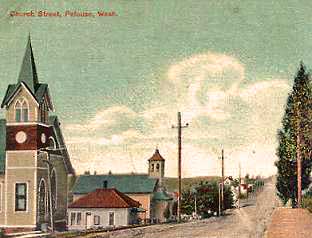 |
Church and was later sold to the Baptists. The building in the center is the Christian Church. It was later doubled in floor size. This photo is looking west on Church Street about 1908. |
The Northwest Tribune of Colfax, Washington reported in 1888 that the trustees of the church "are contemplating building (a) new church building of brick, size 30' x 62', on property in (the) south end of town." (The photo above.)
E. C. Sanderson conducted a gospel meeting for the church in 1889 and reported 35 additions.
The Palouse Republic carried a story in the 1960s about Margaret Redman Sinclair, stating that she was the oldest member of the local Christian Church on record. That record was dated in 1894. Evidently the record-keeping was lax in the earliest days.
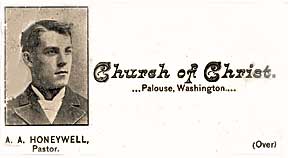 |
-- Contributed by Dennis Carlson |
Another family of this time-frame was Isaiah (Dud) and Mary Mabel Arrasmith. She was a daughter of C. J. and Hannah Wright. Her father had died in 1888. Dud was a blacksmith by trade. They were married by Neal Cheetham in 1895 and spent their years at Palouse and Spokane.
Albert A. Honeywell was the preacher in 1898. He wrote to the Christian Standard publication on January 2 that the church would begin a "meeting next Lord's Day."
Pine City Map
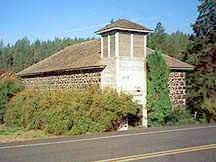 |
is being restored with public help |
Mr. Wright wrote to the Christian Messenger, published at Monmouth, and reported that "most of the young people (in Pine City) belonged to the church." Another comment was, "The singing reminds one of the singing of the angels in heaven."
An early church family was that of Moses Walton Addington and Mary A. Addington. They moved to the area in 1887. They are buried in Pine City Cemetery. His funeral was preached by W. Orchard Hays.
|
Other early members may have included: Mrs. Ella Addington, Burton Davis, George W. Dyer, A. R. Naught, Richard Seaman, A. J. Smith, J. W. VanDyke and Mrs. Nancy Yant. |
The two-county camp meeting of Disciples in Spokane and Whitman Counties was held at Pine City in 1889. S. B. Letson writes,
A large new tent, seventy feet in diameter, has been purchased by the brethren of the two counties. Come prepared to camp. All the preachers of both counties are expected.
Local historian Aleta Simpson reports the present building was remodeled into a church in 1915. Trustees of that property were J. Y. Addington, Elroy Fletcher Smith and A. H. Gustin.
The story goes this way: Originally this was one of the old general stores, but when the train tracks same through, the railroad not only cut off part of the parking area adjacent to the store, the engines scared the horse teams tethered there. So the owner, Andrew Jackson Smith, decided to turn it into a church building and would walk over every day from town to check on construction progress.
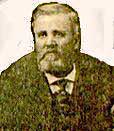 |
Mr. Smith was very deaf, and during one of these daily visits, he forgot to look when crossing the railroad tracks and was hit by a train and killed.
A copy of the original deed conveys the property from Andrew Jackson and Sarah Smith to a board of trustees and states there is to be no piano, organ or other musical instrument played in the church - only a capella singing. Also there were to be no festivals. The final service was held in 1969 and the last funeral was in 1973. The Smiths are buried in the Pine City Cemetery.
The building remains as the oldest building in Pine City that is still useable. It is the last building standing in town made of native granite rock.
The Addingtons and the Smiths are listed in the Pine City Cemetery list.Rosalia Map
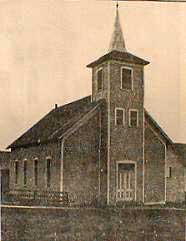 |
We, whose names are hereunto attached, members of the Church of Christ, do agree as a body of Disciples of Christ to meet for worship of Almighty God. The New Testament Scriptures is our only rule of faith and practice.
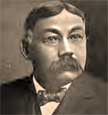
|
A leading family in the new congregation was that of Elijah (Lige) Alexander Whitman the youngest of nine children was born to Squire Stoten Whitman and Elizabeth Davison Whitman on June 7, 1859 in Monmouth, Oregon. He moved to the Washington Territory to join his brother John (Jim) in helping to found Rosalia. He was married to Addie Melvina Kennedy on October 3, l888. W. E. Richardson tied the knot. Mr. Richardson was later elected as superior court judge.
Lige was engaged in several business ventures in Rosalia including a grain business which later became Rosalia Producers. He also homesteaded a farm two miles east of Rosalia. He and his family were active members of the Rosalia Christian Church from its beginning.
Another early family in the Rosalia Christian Church was that of John Edmund Kenedy and Melissa Kenedy.
The town derived its name from the wife of the first postmaster, Rosalia Favorite.
Colfax Map
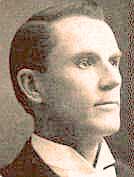 |
It was E. C. Sanderson that organized the 12 disciples that formed the Colfax Church. The year was 1888 and by 1889 they had built a fine brick building. Money was scarce, and it is known that two men gave two horses, each worth about $100, to the building project.
The Disciples Extension Fund loaned money to enable the cashapped church to keep its building.
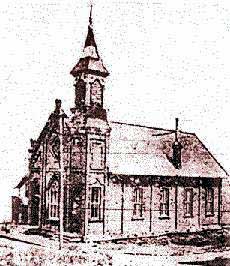 |
August 29, 1891 Supplement |
Early members here included F. L. Bell, B. F. Newcomer, L. D. Phillips, William M. and Almeda Duncan, and Odell V. and Ida Bryson.
Mr. Sanderson, along with Neal Cheetham, held a gospel meeting early in 1889 with 28 additions. When he left the community, there were 43 members.
When Sanderson left, he was replaced by S. B. Letson. R. R. Cook of Palouse preached there in 1891 and 1892. Other preachers included C. F. Goode, and John B. Daisley.
The town, like the one following, was named after a prominent political figure, Schuyler Colfax, vice-president under U. S. Grant.
 |
Garfield MapMr. Stivers lived in the community 15 years. This is remarkable in a time of one-year preaching contracts.The naming of the town had a ring of the Restoration Movement because it was named in honor of the recently assassinated President James Garfield, a leader and minister among the Christian Churches.
This shows the second Garfield building.
It was probably a major addition to the
first that can still be seen in the photo.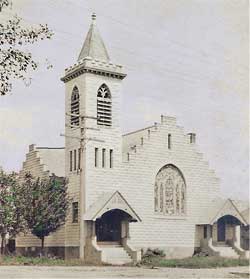
Building in 1915 The interior of the building above. Walter Straub This congregation was organized by C. F. Goode and S. W. P. Richardson early in 1889 with 23 charter members.
The charter members were from the following families: Allison, Bryant, Cox, Ewell, Laird, Mason, McMillion, Richardson, Vernon and Watson. Other early members included Homer Lewis Rouse and Ida Rouse and Henry Sheridan McClure and Amanda (Callison) McClure.
They met in halls and groves until they were able to build in October of the same year. The 30 foot by 60 foot building was located on the southwest corner of Union and 4th Street. George F. Stivers moved from Arkansas to be the first minister in 1889.
Attorney Hiram Joseph Thorn made an eye-popping report to the Christian Standard in February of 1894.
We commenced this meeting the first Sunday in January, and closed last Sunday night, covering three weeks of time, with 52 confessions, 4 added otherwise, making in all 56. Bro. F. Stivers did the preaching, except one very acceptable sermon by Bro. Armitage, late of Arkansas, when he (Armitage) was called to assist in a meeting at Spangle.Bro. Stivers has lived here and preached for this congregation for the past five years, and the large audiences and visible results speak volumes for the life and power of the man. We closed with a crowded house, 2 confessions and a deep interest. . . . The congregation now numbers over 200 and considering the size of this town, only 800 inhabitants, and five denominations represented, we have done well. . . .
Following Stivers, H. J. Thorn was minister briefly. Other ministers were Victor Emanuel Hoven and a personal friend of this writer, the late Clarence A. Boulton. At least four men from the Garfield church have entered full time Christian service: Elijah Stivers, Walter Straub, Cliffford Jope and Wayne Bryant.
Another congregation in the area that has left no history is the church at Silver Creek, about 10 miles NE of Garfield on the Garfield-Farmington Road. All that remains is the cemetery. S. W. P. Richardson was the circuit-riding preacher in 1888.
St. John Map
About the same time as The Washington Territory became a state, the little town of Coin was being renamed in favor of one of its citizens, Alfred St. John. Mr. St. John donated one-half acre for what was to become the Christian Church, the first church in town.
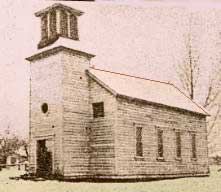 |
The bell tower was later removed. |
According to its own records, this congregation was launched in 1890 as the First Church of Christ of St. John, Washington. The organizing preacher was Samuel B. Letson, then preaching regularly at Colfax. Mr. Letson reported 26 members to the Christian Standard.
The first meetings were in the J. W. Conaway home, and then in Howell's Hall. The church quickly arranged to build. It was completed in the fall of 1890. "It was sturdily built, using square nails...."
The first preacher was Neal Cheetham, who later became Washington State Auditor. Mr. Cheetham had come from Iowa where he attended Oskaloosa College. More about Mr. Cheetham is found under the Waitsburg listing in Walla Walla County.
During Mr. Cheetham's ministry, Nancy Jacobs was converted to Christ. One of her sons, Roy C. Jacobs, became a leading preacher in Washington State.
|
The 26 charter members were: Mr. and Mrs. Green Clark, Wesley Clark, Mrs. Mollie Clark, Frank Clow, Mrs. Mary Clow, Mrs. Mary Conaway, A. J. Duncan, Mrs. Martha Duncan, J. B. Frick, Mrs. Emma J. Fullerton, Mrs. Martha A. Krepta, Robert M. Price, Mrs. Rose Price, James Shelton, Mrs. Minda Shelton, Jonathan B. Smith and Melvina McKee Smith, W. R. Smith, Mrs. Olive E. Smith, James Albert Smith and Ida May Heckman Smith, Marion Smith, Mrs. Smith, Mrs. Alice Waldon (or Weldon), and Mrs. Libbie Wilson. James Albert Smith was a brother of Andrew Jackson Smith at nearby Pine City. The parents were Jonathan and Melvina Smith. |
At one time, the local church historian was May Straub Falk, sister of preacher Walter Straub.
Other preachers beside Cheetham include C. F. Goode, Gentry Rushing, W. R. Smith (Smith was a local man who signed the Articles of Incorporation), R. E. Dunlap, and George F. Stivers of Garfield. Supplina Hamilton lived here in 1904.
Tekoa Map
Tekoa's name name is drawn from Scripture and means "settlement of tents." In the spring of 1891, Tekoa was a city of tents, three years old with a population of six hundred people.
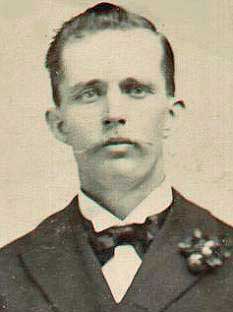 |
Courtesy of Athena Christian Church. |
Among those launching the church there were Mrs. Powell, a widow, who operated a boarding house; Mr. Webb York, a young man who had the first lumber yard in Tekoa; and Mr. R. L. Ricks, Secretary to the Division Superintendent of the Union Pacific Railroad. They met to plan the organization of a New Testament congregation. They held their meetings in the Congregational building for three years. During that time the Christian, Methodist and Congregational churches came together for one Sunday School and one young peoples meeting.
R. R. Cook would come from Colfax and hold meetings every other Sunday. They later met in a public building and a school house. They were able to build a building during 1895-1896. It was on Broadway, four lots north of S. Main on the east side of the street.
Gentry Rushing was the first full time minister. He came on June 1, 1894 but moved to Athena, Oregon in March of 1895.
During one of the early revival meetings Ernest Huffman and his sister Mrs. John T. Brandon were baptized in the creek down from the Brandon buildings. Mr. and Mrs. George P. Huffman gave a lot of their time, talents and money in promoting the work of the Lord in Tekoa. The first baptistry was built in the church in 1898.
Other preachers before 1900 included C. F. Goode, and a L. C. Haulman.
Pullman Map
The exact beginning date of the Pullman Christian Church is not clear, but they dedicated their first building in August of 1892. The Christian Standard of that year reported:
Pullman Christian Church
Built in 1892Last Sunday the handsome new edifice of the Christian Church was formally dedicated and set apart to the worship of God.William F. Cowden was the speaker. The new building was 27 x 42 with a large vestibule at the northwest corner and a smaller one at the southwest corner. An octagon projecting at the rear gave place for the pulpit platform and for an elevated baptistry that was to be installed later. After an offering was received on the day of dedication, the building was debt free.The building was located just south of the intersection of NE Maiden Lane and NE Maple, on the east side of NE Maple. It was heated by steam.
The first building was used as a template for expansion. The existing tower was enlarged and a second, smaller tower, was placed over the smaller door. The auditorium was expanded by adding another ridge at right angles to the first one. There was also a basement.
Early members may have included: Theo. F. Davis, Joseph Farnsworth, William G. Keith, J. E. Lindsey, F. D. Richardson, Mrs. L. C. Richardson and Sophia H. Ringer.
S. B. Letson became the preacher in the late fall of 1892, evidently after the building was completed. He may have spent a year at LaGrande, Oregon and then returned in 1895.
Albion Map
Originally called Guy, the name was changed to Albion in 1915.
First Christian Church Courtesy Albion Historical Society,
A group of believers came together under the night-to-night preaching of Melford Smith of Garfield, WA. Fourteen of them organized into a chuch in 1893 "that we might keep house for the Lord and solicit all to meet with us upon the Bible and the Bible alone." Mr. Smith then included the First Christian Church of Guy in his regular preaching circuit.
By the next year, Thomas L. Childers took the leadership of the new group. R. L. Lotz of Moscow held an evangelistic meeting in 1895. Another was held by J. B. Daisley 1898 and again in 1899.
The group built a meeting house at First and "E" Street in 1900.
Oakesdale Map
This eastern Washington community was named in honor of Thomas F. Oakes, then vice president of Northern Pacific Railroad.
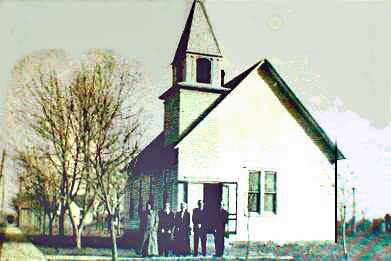 |
Orval Peterson writes,
In the winter of 1891-1892, A. C. Vernon, George F. Stivers, and Neal Cheetham held a series of meetings in the Cumberland Presbyterian Church building. This was the earliest effort of the Disciples in this community.A. C. Vernon is Allen C. Vernon, at 19 converted to Christ by John Alkire Powell near Albany, Oregon. He married Ruth Wheaton and settled in Oakesdale.
By 1899, a congregation was formalized under the leadership of Dr. J. W. Allen of Spokane with 19 charter members. Soon 21 others were added. They built in 1903. Preachers included J. B. Daisley, Peter Rogers Burnett and Neal Cheetham.
In 1936 the Christian Church merged with five denominations forming the Community Presbyterian Church of Oakesdale.
Steptoe Map
The Christians met June 25, 1899 under the guidance of J. W. Allen of Spokane who was preaching for them and urging them to organize themselves into a Church of Christ.
The charter members were C. E. Campbell, T. P. Campbell, A. E. Fish, Harriet Harvey, Ethel Harvey, Mrs. E. Knowles, Annie Lakin, Charles Lambert, D. B. Putnam, Hiram Strode, Mrs. C. J. Swire and Hattie Wilson.
A night-to-night meeting was held soon after the group was organized and there were 40 new people added. As people moved from the area, the church disbanded in 1923 and merged with the Colfax church.
Preachers included Gentry Rushing, John B. Daisley, Peter R. Burnett, and Neal Cheetham.
Yet to be researched in Whitman County: Sunset.
To DOCHS 2/02
Next Chapter: Yakima County or back to Pioneer Menu

